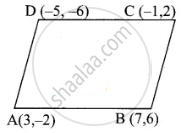Advertisements
Advertisements
Question
Verify that the following points taken in order to form the vertices of a rhombus
A(3, −2), B(7, 6), C(−1, 2) and D(−5, −6)
Solution

Distance = `sqrt((x_2 - x_1)^2 + (y_2 - y_1)^2`
AB = `sqrt((7 - 3)^2 + (6 + 2)^2`
= `sqrt((4)^2 + (8)^2`
= `sqrt(16 + 64)`
= `sqrt(80)`
BC = `sqrt((-1 - 7)^2 + (2 - 6)^2`
= `sqrt((- 8)^2 + (- 4)^2`
= `sqrt(64 + 16)`
= `sqrt(80)`
CD = `sqrt((-5 + 1)^2 + (-6 - 2)^2`
= `sqrt((- 4)^2 + ( - 8)^2`
= `sqrt(16 + 64)`
= `sqrt(80)`
AD = `sqrt((-5 - 3)^2 + (- 6 + 2)^2`
= `sqrt((- 8)^2 + (- 4)^2`
= `sqrt(64 + 16)`
= `sqrt(80)`
AB = BC = CD = AD = `sqrt(80)`
All the four sides are equal.
∴ ABCD is a rhombus.
APPEARS IN
RELATED QUESTIONS
Find the distance with the help of the number line given below.

d (Q, B)
If the co-ordinate of A is x and that of B is y, find d(A, B).
x = 6, y = - 2
Sketch proper figure and write the answer of the following question.
If A- B - C and l(AC) = 11, l(BC) = 6.5, then l(AB) = ?
Co-ordinates of the pair of points are given below. Hence find the distance between the pair.
-9, -1
Find the distance between the following pair of points
(1, 2) and (4, 3)
Find the distance between the following pair of points
(3, −9) and (−2, 3)
Determine whether the given set of points are collinear or not
(a, −2), (a, 3), (a, 0)
Show that the following points taken in order to form the vertices of a parallelogram
A(−3, 1), B(−6, −7), C(3, −9) and D(6, −1)
The radius of a circle with centre at origin is 30 units. Write the coordinates of the points where the circle intersects the axes. Find the distance between any two such points.
If (x + 2, 4) = (5, y – 2), then the coordinates (x, y) are _____
